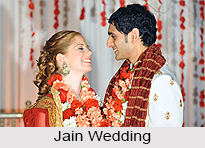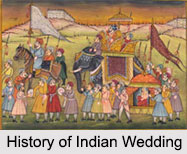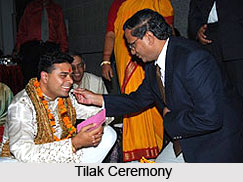 Jainism preaches the peaceful co-existence and communication of two different living beings in mutual beneficence or mutual reliance. In Jain wedding ceremony, a grand public announcement is made of the purpose of the soon-to-be bride and groom to live together for their entire life. Life is thought to be a gift to be shared together, helping each other to live and grow. Jains have this wonderful prayer in their hearts always for forgiveness for all living creations also seeking and receiving the forgiveness of all beings.
Jainism preaches the peaceful co-existence and communication of two different living beings in mutual beneficence or mutual reliance. In Jain wedding ceremony, a grand public announcement is made of the purpose of the soon-to-be bride and groom to live together for their entire life. Life is thought to be a gift to be shared together, helping each other to live and grow. Jains have this wonderful prayer in their hearts always for forgiveness for all living creations also seeking and receiving the forgiveness of all beings.
Jains regard marriage as more or less a sophisticated affair. Marriage and family raising are not compulsory to all the Jain Shravakas. The children born of the wedlock would become the disciple of the Jain dharma only. Some important information on Jain matrimonial customs & traditions are explained in this article.
Match Making in Jain Wedding
Jains strictly believe in marrying within the community and they feel that the children thus born would also become Jains only. They choose their partners for their eligible boy or girl by word of mouth. They get their children wedded to the other known people in their society.
The Jain brides wear sarees only and they prefer the color red or any other bright color. The Jain grooms wear the traditional Kurta Pyajama or the Dhoti Kurta.
Pre Wedding Rituals in Jainism
Rituals like Laghana Lekhan, Lagna Patrika Vachan, Sagai, Mada Mandap, Barati and Aarti make up the rites to be completed before the main wedding ceremony.
Ghudhchadi is a ritual that is performed before on the marriage day before the barat or the groom`s procession leaves for the bride`s place. The Ghudhchadi ritual is when the groom given his headgear and his mother and all the relatives apply tika on his forehead. After this the groom rides the horse and then visits a nearby temple.
Laghana Lekhan - In Laghana Lekhan, the marriage is fixed. On this occasion, pooja is held at the girl`s house and relatives are invited. The priest determines the lagna, also known as the mahurat. Finally, the lagna patrika or a letter tells about the time of marriage is sent to the boy`s house. It is also customary to send ¾ kg of sweets, especially laddoos at the time of engagement or sagai. The sweets could also be sent in an propitious time.
Lagna Patrika Vachan - The Lagna Patrika Vachan is read out in the boy`s house. This is done on either the engagement day or any other auspicious moment. After this the priest reads the letter after the groom has performed the Vinayakyantra Pooja.
Sagai - Engagement or sagai ceremony is held at the groom`s house. The groom would wear the traditional Jain headgear, wash his hands and do the Vinayakyantra. After the Vinayakyantra pooja, the bride`s brother puts on tilak on the groom`s forehead and gifts him a gold chain, a ring, clothes, coconut, sweets and money. The groom is then presented the lagna patrika. The priest reads out the patrika and the groom asks for the blessings of the elders.
Mada-mandap - After Sagai, the next most important ceremony is Mada-mandap. It is held a day or two before marriage. This ceremony is celebrated both at the groom`s as well as the bride`s homes. The hour for the occasion is a pre-determined propitious hour. The priest would execute all the rituals.
Barati - The barati is a ritual that takes place at the girl`s home. It is upon arrival of the barat or the groom`s procession that the bride`s brother greets the groom and applies tika on his forehead. He is also offered with coconut, money, sweet and clothes. In return, the groom also applies tika on the forehead of the bride`s brother and presents him a coconut.
Aarti - After receiving the groom with all honor, the married women do an aarti of the groom. They also sing the Mangala Geet.
Wedding Rituals
The wedding rituals consist of fulfillment of ceremonies like Phere, Kanyavaran, Havan and Granthi Bandhan. Marriage Rituals
Phere - Phere is the most important ceremony in Indian marriages. Phere also an auspicious time, when the groom and the bride would be taken to the mandap and made them seated on a decorated seat. The girl sits to the right of the groom, the groom and the bride changes position after taking the seven vows.
Kanyavaran - This ritual is also known as the kanyapradan ceremony, it has the parents or the uncle of the bride keeping one rupee and twenty-five paise and rice on the right hand of the bride. And then the presentation of the bride to the groom takes place. The father would publicly declare this formal presentation of the bride in front all the gathered guests. The groom then receives the bride. This occasion is denoted with the priest pouring water on the hands of the bride and groom chanting the mantra three times.
Havan - The havan starts just after the Phere. During the havan, a series of mantras are chanted those of the Peethika, Atha Gathu, Atha Nistarak, Atha Surendra, Atha Parmarajadi and Atha Paramesthi are recited and offerings are made. At the end of these mantras, the Shanti mantra is recited nine times.
Granthi Bandhan - Granthi Bandhan is performed after the havan. In this a married woman takes the corner of the pallu of the bride`s sari and then ties it to the shawl of the groom. A mantra is also recited in this occasion. After this the couple takes four rounds of the fire. In this the bride leads while taking the first round. Then they exchange positions and take another three rounds. The recitation of Mahaveerakshak stoot in the background is recited now. The women also start singing the mangal geet at this time. A muhurta or auspicious moment has been already decided previously.
After the phere, the groom and the bride exchange the seven vows. After this, the couple exchange garlands. Finally, the havan ends with the Shantipath and Visarjan.
Post Wedding Rituals
There are certain rituals to be followed after the marriage amongst Jains; including the Ashirvada ceremony, Sva Graha Aagamana custom, Jina Grahe Dhan Arpana tradition and Reception.
After the marriage is over, parents and relatives offer blessings to the couple. The priest also blesses the newly weds and chants a mantra. As in all marriages, a wedding feast for the gathered guests follows this. Now the remaining ritual is left and that of sending the bride to the groom`s house. The Jains believe in giving away alms and donations in Jain temples as a thanksgiving to the God.
When the women receive the groom at the reception, they do the Aarti and also sing the auspicious Mangala Geet. Jains are austerely vegetarians. The usual wedding menu comprises the specialties of the localities.
The Jain marriage custom is dominated by the customary practices, which of course vary from community to community. Some rituals are common to all Jain marriages. For the Jains, marriage means a community declaration of a man and a woman`s intention to be together for the entire life. The community supports the couple by being a part of it. The Jain community assembles on various occasions and has condemned the practice of negotiating a dowry before the ritual of marriage. Jains believe that there should be no waste of money or time behind unnecessary extravagancies. Nevertheless, marriage is a once-in-lifetime occasion and is celebrated properly and grandly. The Jain pundits mostly conduct Jain marriages.
More on Indian Religious Weddings
More on Indian Wedding Accessories
More on Indian Religious Weddings
More on Types of Marriages
See also
 Jainism preaches the peaceful co-existence and communication of two different living beings in mutual beneficence or mutual reliance. In Jain wedding ceremony, a grand public announcement is made of the purpose of the soon-to-be bride and groom to live together for their entire life. Life is thought to be a gift to be shared together, helping each other to live and grow. Jains have this wonderful prayer in their hearts always for forgiveness for all living creations also seeking and receiving the forgiveness of all beings.
Jainism preaches the peaceful co-existence and communication of two different living beings in mutual beneficence or mutual reliance. In Jain wedding ceremony, a grand public announcement is made of the purpose of the soon-to-be bride and groom to live together for their entire life. Life is thought to be a gift to be shared together, helping each other to live and grow. Jains have this wonderful prayer in their hearts always for forgiveness for all living creations also seeking and receiving the forgiveness of all beings.



















